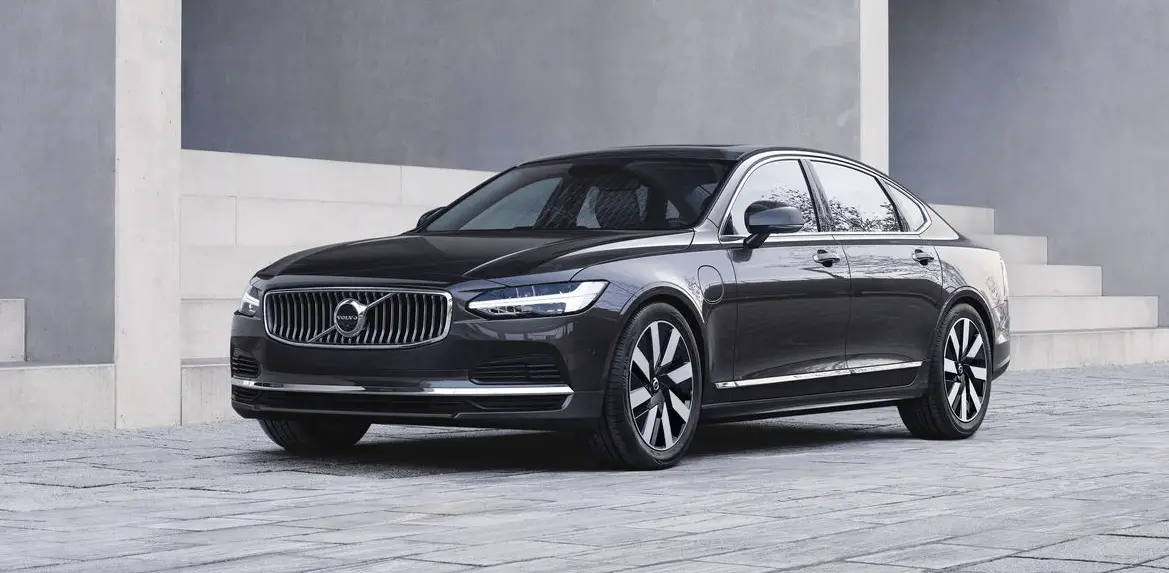Volvo S90 2021-2023 SPECIFICATIONS User Manual
From 2021 to 2023, the Volvo S90 will be the most luxurious and well-designed premium car to come out of Scandinavia. The S90 is a great example of Volvo’s approach to making cars with both style and substance. It has a unique mix of elegance, innovation, and performance. The S90 offers a good balance between power and fuel economy thanks to its many engine choices, which include hybrid models. Its interior accepts the idea of minimalist luxury with high-quality materials and a layout that puts the user first. Modern technology, like improved safety features and a high-tech infotainment system, is built into the driving experience in a seamless way. The S90’s refined comfort and driving dynamics make it a standout in the competitive luxury car market, whether you’re driving in the city or going on a long trip.
SPECIFICATIONS
Type designations
The decals in the car contain information such as chassis number, type designation, colour code, etc.
Label location
The illustration is schematic – details may vary depending on market and model.
Knowing the car’s type designation, vehicle identification and engine numbers can facilitate all contact with an authorised Volvo dealer regarding the car and when ordering spare parts and accessories.
- Decal for type designation, vehicle identification number, permissible maximum weights and code designation for exterior colour and type approval number. The decal is positioned on the door pillar, and will be visible when the right-hand rear door is opened.
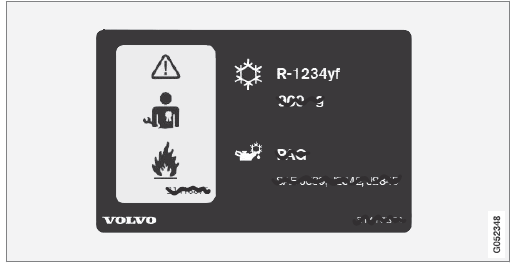
- Decal for A/C system for cars with refrigerant R1234yf.
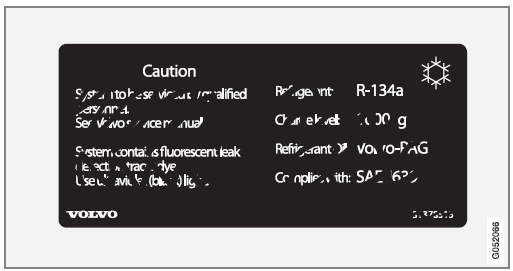
- Decal for A/C system for cars with refrigerant R134a.
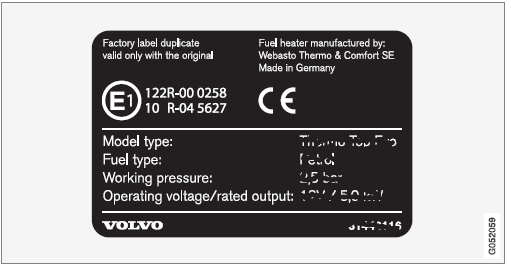
- Label for parking heater.

- Decal for engine code and the engine’s serial number. For certain engine alternatives there is no decal. In these cases, the engraved engine code can be read directly on the engine instead.
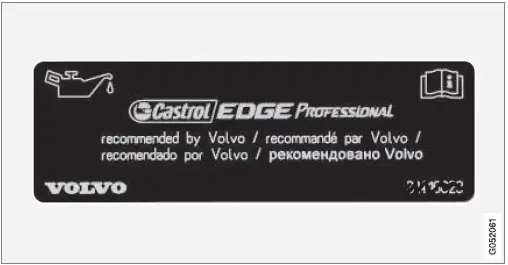
- Label for engine oil.

- Decal for gearbox type designation and serial number.
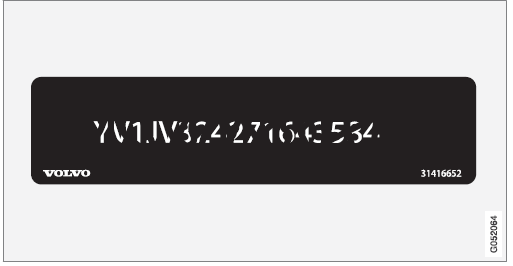
- Decal for the car’s identification number -VIN (Vehicle Identification Number).
Further information on the car is presented in the registration document.
NOTE
It is not intended that the decals illustrated in the owner’s manual should be exact rep-licas of those in the car. They are included to show their approximate appearance and locations in the car. The information that applies to your particular car can be found on the decal on the car.
Related information
Air conditioning — specifications (p. 666)
Dimensions
Measurement of car length, height, etc. can be read in the table.
| Dimensions | mm | inches | |
| A | Ground clearance A | 142 | 5.6 |
| B | Wheelbase | 2872 | 113.1 |
| C | Length | 4761 | 187.4 |
| D | Load length, floor, folded seat | 1797 | 70.7 |
| E | Load length, floor | 1005 | 39.6 |
| F | Height B | 1437 | 56.6 |
| Dimensions | mm | inches | |
| G | Load height | 485 | 19.1 |
| H | Front track | 1603C | 63.1C |
| 1600D | 63.0D | ||
| 1593E | 62.7E | ||
| I | Rear track | 1603C | 63.1C |
| 1600D | 63.0D | ||
| 1593E | 62.7E |
| Dimensions | mm | inches | |
| J | Load width, floor | 867 | 34.1 |
| K | Width | 1850 | 72.8 |
| Dimensions | mm | inches | |
| L | Width including door mirrors | 2040 | 80.3 |
| M | Width including folded-in door mirrors | 1916 | 75.4 |
- A At kerb weight plus 1 person. (Varies slightly depending on
tyre dimension, chassis option, etc.)
B Including roof antenna, for kerb weight.
C Applies to cars with 17 inch wheels.
D Applies to cars with 18/19 inch wheels.
E Applies to cars with 20 inch wheels.
Related information
Weights (p. 657)
Weights
Max. gross vehicle weight, etc. can be read on a label in the car.
Kerb weight includes the driver, the fuel tank 90% full, plus and all oils and fluids.
The weight of passengers and accessories, and tow ball load (when a trailer is hitched) influence the load capacity and are not included in the kerb weight.
Permitted max. load = Gross vehicle weight Kerb weight.
NOTE
The documented kerb weight applies to cars in the standard version – i.e. a car without extra equipment or accessories. This means that for every accessory added the loading capacity of the car is reduced correspondingly by the weight of the accessory.
Examples of accessories that reduce load capacity are the different equipment levels (e.g. Kinetic, Momentum, Summum), as well as other accessories such as tow bar, load carrier, space box, audio system, auxiliary lamps, GPS, fuel-driven heater, safety grille, carpets, cargo cover, power seats, etc.
Weighing the car is a certain way of ascertaining the kerb weight of your own particular car.
WARNING
The car’s driving characteristics change depending on how heavily it is loaded and how the load is distributed.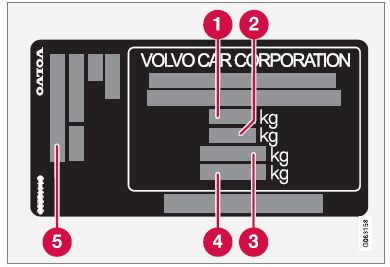 The decal is positioned on the door pillar, and will be visible when the right-hand rear door is opened.
The decal is positioned on the door pillar, and will be visible when the right-hand rear door is opened.
- Max. gross vehicle weight
- Max. train weight (car+trailer)
- Max. front axle load
- Max. rear axle load
- Equipment level
Max. load: See registration document. Max. roof load: 75 kg.
Related information
Towing capacity and towball load
Towing capacity and towball load for driving with a trailer can be read in the tables.
Max. weight braked trailer
NOTE
Use of vibration dampers on the towbar is recommended for trailers heavier than 1800 kg.
| Engine | Engine code | Gearbox | Max. weight braked trailer (kg) | Max. towball load (kg) |
| T4 | B4204T44 | Automatic | 1800 | 100 |
| T5 | B4204T23 | Automatic | 1800 | 100 |
| T5 AWD | B4204T23 | Automatic | 1800 | 100 |
| T5 AWD | B4204T20 | Automatic | 1800 | 100 |
| T6 AWD | B4204T27 | Automatic | 2000 | 100 |
| B3 | B420T3 | Automatic | 1800 | 100 |
| B4 | B420T6 | Automatic | 1800 | 100 |
| B5 | B420T2 | Automatic | 1800 | 100 |
| B5 AWD | B420T2 | Automatic | 1800 | 100 |
| B6 AWD | B420T | Automatic | 2000 | 100 |
A The engine code, component number and serial number can be found on the engine.
IMPORTANT
When driving with a trailer, it is permitted to exceed the vehicle’s gross vehicle weight (including towball load) by a maxi-mum of 100 kg (220 lbs), provided that speed is limited to 100 km/h (62 mph). National legal requirements for the vehicle combination, such as speed, etc. must be observed.
NOTE
If there is no weight data in the table, this is available in an enclosed supplement.
Max. weight unbraked trailer
| Max. weight unbraked trailer (kg) | Max. towball load (kg) |
| 750 | 50 |
Related information
- Type designations (p. 652)
Weights (p. 657)
Driving with a trailer (p. 474)
Trailer stability assist* (p. 476)
Engine specifications
Engine specifications (power, etc.) for each respective engine alternative can be found in the table below.
NOTE
Not all engines are available in all markets.
NOTE
If there is no engine data in the table, this is available in an enclosed supplement.
| Engine | Engine codeA | Output (kW/rpm) | Output (hp/rpm) | Max. rated power
(kW/rpm) |
Max. rated power
(hp/rpm) |
Torque (Nm/rpm) | No. of cyl- inders |
| T3 | B4204T50 | 120/5000 | 163/5000 | 133/5000 | 181/5000 | 265/1600–3800 | 4 |
| T4 | B4204T31 | 140/5000 | 190/5000 | 156/5000 | 211/5000 | 300/1700–4000 | 4 |
| T4 | B4204T44 | 140/5000 | 190/5000 | – | – | 300/1400-4000 | 4 |
| T5 | B4204T26 | 184/5500 | 250/5500 | 205/5500 | 278/5500 | 350/1800-4800 | 4 |
| T5 / T5 AWD | B4204T23 | 187/5500 | 254/5500 | – | – | 350/1500–4800 | 4 |
| T5 AWD | B4204T20 | 183/5500 | 249/5500 | – | – | 350/1500-4500 | 4 |
| T6 AWD | B4204T27 | 235/5700 | 320/5700 | – | – | 400/2200-5400 | 4 |
| B3 | B420T3 | 120/4800 | 163/4800 | – | – | 265/1500–3900 | 4 |
| B4 | B420T6 | 145/4800–5400 | 197/4800–5400 | – | – | 300/1500–4200 | 4 |
| B5 / B5 AWD | B420T2 | 184/5400–5700 | 250/5400–5700 | – | – | 350/1800-4800 | 4 |
| B6 AWD | B420T | 220/5400 | 300/5400 | – | – | 420/2100–4800 | 4 |
Related information
Engine oil — specifications
Engine oil grade and volume for each respective engine alternative can be read in the table.

| Engine | Engine codeA | Oil grade | Volume, incl. oil filter
(litres, approx.) |
| T3 | B4204T50 | Castrol Edge Professional V 0W-20 or VCC RBS0-2AE 0W-20 | 5.6 |
| T4 | B4204T31 | 5.6 | |
| T4 | B4204T44 | 5.6 | |
| T5 | B4204T26 | 5.6 | |
| T5 / T5 AWD | B4204T23 | 5.6 | |
| T5 AWD | B4204T20 | 5.6 | |
| T6 AWD | B4204T27 | 5.6 |
Related information
- Type designations (p. 652)
- Adverse driving conditions for engine oil (p. 664)
- Checking and filling with engine oil (p. 606)
- Engine oil (p. 605)
Adverse driving conditions for engine oil
Adverse driving conditions can lead to abnormally high oil temperature or oil consumption. Below are some examples of adverse driving conditions.
Check the oil level more frequently for long journeys:
- Towing a caravan or trailer
- In mountainous regions
- At high speeds
- In temperatures colder than -30 °C (-22 °F) or hotter than +40 °C (+104 °F).
The above also apply to shorter driving distances at low temperatures.
Choose a fully synthetic engine oil for adverse driving conditions. It provides extra protection for the engine.
Volvo recommends:
IMPORTANT
In order to fulfil the requirements for the engine’s service intervals all engines are filled with a specially adapted synthetic engine oil at the factory. The choice of oil has been made very carefully with regard to service life, starting characteristics, fuel consumption and environmental impact.
An approved engine oil must be used in order that the recommended service intervals can be applied. Only use a prescribed grade of oil for both filling and oil change, otherwise there is a risk of the service life, starting characteristics, fuel consumption and environmental impact of the car being affected.
If engine oil of the prescribed grade and viscosity is not used, engine related components may become damaged. Volvo dis-claims any liability for any such damage.
Volvo recommends that oil changes are carried out at an authorised Volvo work-shop.
Related information
Transmission fluid – specifications
Under normal driving conditions, the trans-mission fluid does not need to be changed during the service life of the gearbox. How-ever, it may be necessary in adverse driving conditions.
Automatic gearbox
Prescribed transmission fluid
TG-81SC: AW-1
AWF8G45:
AWF8G55:
AW-2
Related information
Type designations (p. 652)
Brake fluid – specifications
Brake fluid is the medium in a hydraulic brake system that is used to transfer pressure from e.g. a brake pedal via a master brake cylinder, which in turn acts on the brake callipers. Prescribed grade: Volvo Original or equivalent fluid compliant with a combination of Dot 4, 5.1 and ISO 4925 class 6.
NOTE
It is recommended that brake fluid is changed or filled by an authorised Volvo workshop.
Related information
Engine compartment overview (p. 604)
Fuel tank – volume
- The fuel tank’s filling capacity can be read in the table below.
-
All models Litres (approx.) 60 US gallons (approx.) 15.9
Related information
Filling fuel (p. 463)
Air conditioning — specifications
The car’s climate control system uses a freonfree refrigerant either R1234yf or R134a depending on market. Information about which refrigerant the car’s climate control system uses is printed on a decal located on the inside of the bonnet.
Prescribed grades and volumes of fluids and lubricants in the air conditioning system can be read below.
A/C decal
Decal for R134a
Symbol explanation R1234yf
| Symbol | Meaning |
 |
Caution |
| Mobile air conditioning system (MAC) | |
 |
Lubricant type |
| Symbol | Meaning |
 |
A trained and certified technician is required in order to service the mobile air conditioning system (MAC) |
 |
Flammable refrigerants |
Refrigerant
Refrigerant amount is printed on the decal located on the inside of the bonnet.
Cars with R134a refrigerant
- Refrigerant amount.
WARNING
The air conditioning system contains pressurised refrigerant R134a. This system must only be serviced and repaired by an authorised workshop.
Cars with R1234yf refrigerant
Refrigerant amount.
WARNING
The air conditioning system contains pressurised refrigerant R1234yf. In accordance with SAE J2845 (Technician Training for Safe Service and Containment of Refrigerants Used in Mobile A/C System), service and repair of the refrigerant system must only be performed by trained and certified technicians in order to ensure the safety of the system.
Compressor oil
| Volume | Prescribed grade |
| 100 ml (3.38 fl. oz.) | PAG SP-A2 |
Evaporator
IMPORTANT
The A/C system’s evaporator must never be repaired or replaced with a previously used evaporator. A new evaporator must be certified and labelled in accordance with SAE J2842.
Related information
Servicing the climate control system (p. 602)
Fuel consumption and CO2 emissions
The information in the tables below is in accordance with WLTP (Worldwide Harmonised Light-Duty Vehicles Test Procedure), which is an international test method for vehicles equivalent to a passenger car designed for laboratory testing. The fuel consumption for a vehicle is measured in liters per 100 km and carbon dioxide emissions (CO2) are measured in gram CO2 per km.
Explanation
| Urban driving (slow) | |
| Suburban driving (average) |
| Extra-urban driving (fast) | |
| Motorway driving (very fast) | |
| Combined value (combined driv ing) | |
| Gram CO2/km | |
| Litres/100 km | |
| Manual gearbox | |
| Automatic gearbox |
| Low value | |
| High value |
|
|
 |
 |
 |
 |
 |
|||||||
|
B3 (B420T3) |
Aut |  |
– | – | – | – | – | – | – | – | – | – |
 |
– | – | – | – | – | – | – | – | – | – | ||
|
|
 |
 |
 |
 |
 |
|||||||
 |
 |
 |
 |
 |
 |
 |
 |
 |
 |
|||
|
B4 (B420T6) |
Aut |  |
– | – | – | – | – | – | – | – | – | – |
 |
– | – | – | – | – | – | – | – | – | – | ||
|
B5 (B420T2) |
Aut |  |
– | – | – | – | – | – | – | – | – | – |
 |
– | – | – | – | – | – | – | – | – | – | ||
|
B5 AWD (B420T2) |
Aut |  |
– | – | – | – | – | – | – | – | – | – |
 |
– | – | – | – | – | – | – | – | – | – | ||
|
B6 AWD (B420T) |
Aut |  |
– | – | – | – | – | – | – | – | – | – |
 |
– | – | – | – | – | – | – | – | – | – | ||
The values in the table above for fuel consumption and CO2 emissions are based on special drive cycles (see below). The car’s weight may increase depending on its equipment level. Together with how heavily the car is loaded, this affects fuel consumption and CO2 emissions. According to WLTP, every car has unique fuel consumption and CO2 emission values depending on how the car is equipped. These values range between the low value and high value in the table above. In many markets, you can find your car’s unique fuel consumption and CO2 emission values in the car’s registration document.
There are several reasons for fuel consumption that is higher than the values in the table.
Examples of these include:
- If the car is equipped with extra equipment that affects its weight.
- Driving style.
- If the customer chooses wheels other than those mounted as standard on the basic version of the model, this could increase rolling resistance.
- High speed causes increased air resistance.
- Fuel quality, road and traffic conditions, weather and the condition of the car.
A combination of the examples above could increase consumption considerably.
There may be huge deviations in fuel consumption if compared to the drive cycle profiles (see below), which are used in the certification of the car and on which consumption figures in the table are based. For further information, please refer to the referenced regulations.
NOTE
Extreme weather conditions, driving with a trailer or driving at high altitudes, in combination with poorer fuel quality than recommended, are factors that considerably increase the car’s fuel consumption.
WLTP standard
From and including 1 September 2018, a new standard was introduced for calculating consumption values in the car. The WLTP standard (Worldwide Harmonised Light-Duty Vehicles Test Procedure) represents the average driving conditions for everyday driving. In comparison with the previous standard (NEDC), WLTP takes into account more varied traffic situations and speeds, but also equipment and weight classes. Optional equipment that affects consumption is deactivated during testing, e.g. air conditioning, seat heating, etc. The new standard should provide more realis-tic figures when it comes to fuel consumption, carbon dioxide and emissions. The values are intended to allow comparison between different cars and not to represent your typical nor-mal consumption.
Drive cycle profiles
A drive cycle simulates actual average driving of the car. The standard is based on four different drive cycle profiles.
The four drive cycle profiles are:
- Urban driving – slow driving
- Suburban driving – average driving
- Extra-urban driving – fast driving
Motorway driving – very fast driving.
Every drive cycle is determined by different conditions such as speed, time and mileage, for example.
The official value for combined driving, which is shown in the table, is a combination of the results from the four drive cycles, in accordance with legal requirements.
The exhaust gases are collected in order to extrapolate the carbon dioxide emissions (CO2 emissions) during the four drive cycles. These were then analysed to determine the value for CO2 emissions.
Related information
Approved wheel and tyre sizes
In certain countries not all approved sizes are indicated by the registration document or other documents. The following table shows all approved combinations of wheel rims and tyres.
= Approved
| Engine | man/
aut |
215/60R16A
7x16x37 |
225/50R17B
7x17x40.5C |
235/45R18
8x18x42 |
235/40R19
8x19x42 |
245/35R20D
8x20x45.5 |
| T3 (B4204T50) | aut | ✓ | ✓ | ✓ | ✓ | ✓ |
| T4 (B4204T31) | aut | ✓ | ✓ | ✓ | ✓ | ✓ |
| T4 (B4204T44) | aut | ✓ | ✓ | ✓ | ✓ | ✓ |
| T5 (B4204T26) | aut | – | ✓ | ✓ | ✓ | ✓ |
| T5 (B4204T23) | aut | – | ✓ | ✓ | ✓ | ✓ |
| T5 AWD (B4204T20) | aut | – | ✓ | ✓ | ✓ | ✓ |
| T5 AWD (B4204T23) | aut | – | ✓ | ✓ | ✓ | ✓ |
| T6 AWD (B4204T27) | aut | – | – | ✓ | ✓ | ✓ |
| B3 (B420T3) | aut | ✓ | ✓ | ✓ | ✓ | ✓ |
| B4 (B420T6) | aut | ✓ | ✓ | ✓ | ✓ | ✓ |
| B5 (B420T2) | aut | – | ✓ | ✓ | ✓ | ✓ |
| B5 AWD (B420T2) | aut | – | – | ✓ | ✓ | ✓ |
| B6 AWD (B420T) | aut | – | – | ✓ | ✓ | ✓ |
A 215/60 R16 is not approved when the car is equipped with 17″ or 18″ brakes. Check with your Volvo dealer how your car is equipped.
B 225/50 R17 is not approved when the car is equipped with 18″ brakes. Check with your Volvo dealer how your car is equipped.
C 17″ Aero must not be fitted to cars equipped with 16″ brakes. Check with your Volvo dealer how your car is equipped.
D 245/35 R20 is only approved for cars originally sold with 20″ tyres in combination with sport chassis. Check with your Volvo dealer how your car is equipped.
Related information
- Minimum permitted tyre load index and speed rating for tyres (p. 673)
- Type designations (p. 652)
- Dimension designation for tyre (p. 558)
- Dimension designation for wheel rim (p. 559)
- Snow chains (p. 574)
Minimum permitted tyre load index and speed rating for tyres
The table below shows minimum permitted load index (LI) and speed rating (SS).
| Engine | man/
aut |
Minimum permitted load index (LI)A | Minimum permitted speed rating (SS)B |
| T3 (B4204T50) | aut | 94 | H |
| T4 (B4204T31) | aut | 94 | H |
| T4 (B4204T44) | aut | 94 | H |
| T5 (B4204T26) | aut | 94 | H |
| T5 (B4204T23) | aut | 94 | H |
| T5 AWD (B4204T23) | aut | 94 | H |
| T5 AWD (B4204T20) | aut | 94 | H |
| T6 AWD (B4204T27) | aut | 94 | H |
| B3 (B420T3) | aut | 94 | H |
| B4 (B420T6) | aut | 94 | H |
| B5 (B420T2) | aut | 94 | H |
| B5 AWD (B420T2) | aut | 94 | H |
| B6 AWD (B420T) | aut | 94 | H |
- The tyre’s load index must be at least equal to or greater than indicated in the table.
- The tyre’s speed rating must be at least equal to or greater than indicated in the table.
Related information
- Approved wheel and tyre sizes (p. 671)
- Approved tyre pressures (p. 675)
- Type designations (p. 652)
- Dimension designation for tyre (p. 558)
- Dimension designation for wheel rim (p. 559)
Approved tyre pressures
Approved tyre pressures for each engine alternative can be found in the table.
NOTE
All engines, tyres or combinations of these are not always available in all markets.
| Engine | Tyre size | Speed | Load, 1-3 persons | Max. load | ECO pressureA | ||
| Front
(kPa)B |
Rear
(kPa) |
Front
(kPa) |
Rear
(kPa) |
Front/rear
(kPa) |
|||
| 215/60 R16 | 0-160 km/h (0-100 mph) | 230 | 230 | 260 | 260 | 260 | |
| 225/50 R17 | |||||||
| All engines | 235/45 R18
235/40 R19 |
160+ km/h (100+ mph) |
280 |
280 |
310 |
310 |
– |
| 245/35 R20 | |||||||
| Temporary Spare Tyre | max 80 km/h (max 50 mph) | 420 | 420 | 420 | 420 | – | |
Economical driving.
B In certain countries the “bar” unit is used alongside the SI unit “Pascal”: 1 bar = 100 kPa.
Related information
- Type designations (p. 652)
- Checking tyre pressure (p. 560)
- Approved wheel and tyre sizes (p. 671)
- Recommended tyre pressure (p. 562)
-
FAQ
The Volvo S90 typically offers a range of engine options including turbocharged and supercharged four-cylinder engines, possibly with hybrid variants as well.
The most powerful engine variant can produce around 300 to 400 horsepower, depending on the specific model and year.
Yes, all-wheel drive (AWD) is often available as an option for the Volvo S90.
The Volvo S90’s interior is known for its minimalist Scandinavian design, featuring high-quality materials, a large infotainment touchscreen, and comfortable seating.
The S90 typically includes advanced safety features like adaptive cruise control, lane-keeping assist, and automated emergency braking. It also features a user-friendly infotainment system with smartphone integration.
The S90 is usually a five-passenger luxury sedan.
As of my last update in September 2021, the starting price for the Volvo S90 was around $50,000, but this can vary based on trim level, optional features, and any updates for the 2023 model year.
The S90 typically comes in multiple trim levels, which could include options like Momentum, Inscription, and possibly a performance-oriented trim like R-Design.
Yes, the Volvo S90 often offers hybrid powertrain options that combine a gasoline engine with an electric motor for improved efficiency.
The S90 is typically equipped with an automatic transmission.
Standard safety features often include adaptive cruise control, automatic emergency braking, blind-spot monitoring, and lane-keeping assist.
The S90 typically offers features like premium leather upholstery, heated and ventilated seats, a panoramic sunroof, and high-end audio systems.
Fuel economy can vary based on the engine and hybrid options, but the S90 generally offers competitive fuel efficiency for its class.
Yes, the R-Design trim or similar options are often more performance-oriented, offering sportier styling and potentially more powerful engines.
Competitors to the Volvo S90 include vehicles like the BMW 5 Series, Mercedes-Benz E-Class, Audi A6, and Lexus ES.

